22.10.2007
M.Notkin. Sir G.Thomas Passion
I start to show some creativity successes of August 2007. I shall omit games of the Russia – China match partially because they have been commented elsewhere already. In this review we shall meet foreign guests: Dutchmen, Serbians, Frenchmen. Let us begin with a battle, in which leading grandmaster of the Netherlands compromised only under insuperable circumstances. I.Sokolov – L.van Wely
1.d4 d5 2.c4 c6 3.¤c3 ¤f6 4.¤f3 e6 5.e3 ¤bd7 6.Ґd3 dxc4 7.Ґxc4 b5 8.Ґd3 Ґb7 9.0–0 a6 10.a4 b4 11.¤e4 c5 12.¤xf6+.

12...Јxf6. 12...gxf6 occurred in the 5th game of candidates match Gelfand – Kasimdhzanov, Elista 2007. The position is familiar to Ivan Sokolov: Jeroen Piket played so against him in Dordrecht 2002. The game is full of inaccuracies and mistakes, but one moment is worth quoting: 13.e4 (Gelfand preferred13.Јe2) 13...cxd4 14.¤xd4 ¤e5 15.Ґe2 Ґxe4 16.Ґe3 Ґd6 17.f3 Ґb7 18.Јd2 h5?! 19.¦ad1 Ґc5?, and here White missed an opportunity to take the edge by 20.¤xe6! Јxd2 21.¤c7+! – due to the intermediate check he captures both the queen and the bishop.
The most popular reply is 12...¤xf6, however, Boris reminds in his detailed comments in '64' that Black faced troubles after 13.dxc5 Ґxc5 14.Јe2 Јd5 15.¦d1 in the rapid game Kramnik – Kasparov, Zuerich 2001.
13.¦e1. A new continuation. In Skembris – D.Mastrovasilis, Athens 2004, after 13.a5 cxd4 14.exd4 Ґd6 15.¦e1 Ґxf3 16.Јxf3 Јxf3 17.gxf3 ¤f6 a problem endgame arose, which van Wely obviously did not want to go into. Black's pawn structure destroyed, White has a pair of bishops and perspective of long pressing on the a6 pawn.
13.e4!? isinteresting, Kent – Hoff, Haarlem 2000. The move solves perhaps the most urgent problem of White in the Meran variation: makes his dark-squared bishop active. Subsequently, Black lost his queen because of his simple-minded and greedy strategy: 13...cxd4 14.Ґg5 Јg6 15.e5 Јh5 16.Ґe2 ¤xe5 17.¤xe5 Јxg5 18.Ґf3 Јxe5 19.Ґxb7 Ґd6? 20.f4 Јe3+ 21.ўh1 ¦a7 22.Ґc6+ ўe7 23.¦f3!ќ. Nevertheless, he won the game! More weighed 16...Ґc5 led to a position with mutual chances.
13...h6. The most natural 13...Ґd6? fails in view of 14.e4 cxd4 15.Ґg5 Јg6 16.e5. Loek prevents White's second move of the variation.
14.Ґc2 ¦d8. In case of 14...Ґd6 15.dxc5 Black has to lose a tempo for 15...Ґxc5, and he wants full comfort by capturing on c5 with his knight. The ending after 14...Ґxf3 15.Јxf3 Јxf3 16.gxf3 c4 (16...¦c8 17.Ґe4) 17.a5 is not attractive for van Wely as before.
15.a5. The position is ripe for 15.e4 already. A real pearl hides off screen: 15...cxd4 16.e5! Ґxf3? 17.exf6 Ґxd1
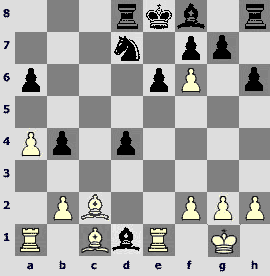
and after 18.¦xe6+!! Black has to part with both bishops in view of a beautiful mate 18...fxe6 19.Ґg6#!
Correct is 16...Јe7 17.¤xd4. Black is only slightly worse but there is some awkwardness. He cannot make use of the pin along the d-file: the white queen is ready to jump on g4 and defending of the knight by the e3 bishop insures against troubles. Including 15...b3 16.Ґd3 cannot change an estimate essentially, besides, White has 16.Ґxb3 cxd4 17.Ґd2, and the bishop receives a job on the e1-a5 diagonal.
15...Ґd6.
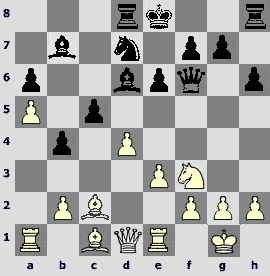
16.h3. 16.Ґa4 prepared by previous ponderous manoeuvres does not achieve its object due to 16...0–0, and either 18.dxc5 Ґxh2+ or 17.e4 cxd4 18.Ґxd7 ¦xd7 19.e5 Ґxf3 lead White to a complete crash.
Black obtains an excellent play after 16.e4 cxd4 17.Јxd4 (in case of 17.¤xd4 ¤c5 White suffers material losses because of pinning along the d-file) 17...Јxd4 18.¤xd4 ¤c5.
The move 16.h3 is not only waiting but useful too. 'Waitingness' exposes itself in case of 16...0–0 17.Јd3 g6 18.e4: the h6 pawn is hanging, White grabs the initiative. Usefulness might bee indirectly seen in the following variations: 16.¤d2 cxd4 17.¤c4.
Now after 17...¤c5 18.exd4 Black strikes 18...Ґxh2+! 19.ўxh2 ¦xd4, and in case of 20.¤d6+ ўf8 21.Јe2 Јh4+ 22.ўg1 Ґxg2! 23.ўxg2 ¦g4+ he gains the queen obtaining a significant advantage. Stronger is 21.Ґe3! ¦xd1 22.¦axd1, and Black cannot defend both minor pieces at once. After resourceful 22...ўg8 23.Ґxc5 Јh4+ 24.ўg1 Ґxg2! 25.ўxg2 Јg5+ 26.ўf1 Јxc5 a chaos reigns on the board.
However, there is more efficient decision: 17...¤e5! 18.¤xd6+ ¦xd6, and if 19.exd4? then 19...¦xd4 20.Јe2 ¦g4! winning.
It is easily seen that in both lines the h3 pawn would be very useful for White. Though it will be clear soon that Ivan did not consider the knight's manoeuvre (or underestimated it).
16...g5. In a sense, a 'waiting move' too, though I think most readers would agree that 16...Ґb8 is more corresponding with the words. Probably White would reply 17.Јe2 taking away the queen form opposition with the rook. He has the same problems choosing a move as before 16.h3 g5.
17.Ґa4? White should play 17.¤d2! cxd4 18.¤c4, and 18...¤c5 he simply captures 19.exd4, and if 18...¤e5 then 19.¤xd6+ ¦xd6 20.exd4 ¦xd4 21.Јe2 with a perfect compensation for a pawn.
17...0–0 18.e4.
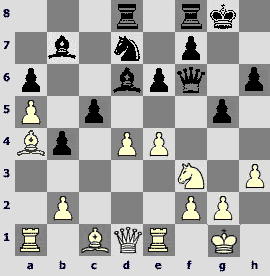
18...Јg7. Thematic 18...cxd4 would give Black bright perspectives, for example 19.Ґxd7 (19.Јxd4 Јxd4 20.¤xd4 ¤c5) 19...¦xd7 20.e5 (in case of 20.Јa4 Јe7 21.¤xd4 ¦c8 White clearly yields in development) 20...Ґxf3 21.Јxd4 Ґxe5 22.Јxd7 Ґd5. Prevailing position of his bishops more than compensates for lack of an exchange. But if black do not like anything here, he has 21...Јg7 22.gxf3 ¦fd8 also. The text move does not lose the advantage.
19.Ґxd7 ¦xd7 20.Јa4 ¦fd8 21.Ґe3 g4! Advancing the g-pawn on move 16 turned out to be a far-sighted action.
22.hxg4 Јxg4. A tongue of flame creeps along the big light-squared diagonal already.
23.dxc5 Ґxe4 24.Јxb4. The position cannot be cured by therapeutic methods: 24.ўf1 Ґxc5! 25.Ґxc5 Ґxf3 26.gxf3 Јh3+ 27.ўg1 ўh7°.
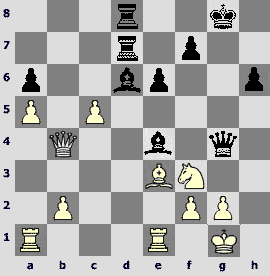
24...Ґe5? A wrong redaction. 24...Ґf4! led to a technically won position: 25.Јxe4 (25.¤h4 Ґxe3 26.¦xe3 ¦d1+ 27.¦xd1 ¦xd1+ 28.¦e1 ¦xe1+ 29.Јxe1 Јxh4) 25...Ґh2+ 26.ўxh2 Јxe4 27.Ґg5, and after precise 27...Јb4! 28.Ґxd8 ¦xd8 29.¦ac1 ¦c8 30.c6 Јd6 White loses his only hope.
25.Ґxh6. In case of 25.¦a4? ¦d4! Black wins tight struggle for the 4th rank.
25...Ґd4. On 25...¦d4 would follow 26.¦xe4! ¦xe4 27.Јb7, and soon there will be a lot of white passed pawns on the queenside, while minor pieces protect approaches to the king on the opposite side. 25...f5 26.Јb3 led to a complicated play, but not 26.¦xe4? fxe4 27.¤xe5? ¦d1+ 28.¦xd1 ¦xd1+ 29.ўh2 Јh4#.
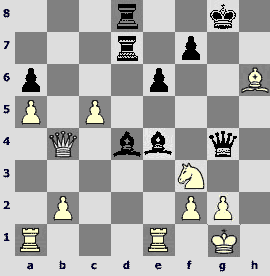
26.¦xe4! Јxe4 27.Ґe3 e5 28.Ґxd4 exd4 29.¦e1. After 29.Јb6 d3 30.c6 ¦d5 31.c7 ¦c8 Black blocks the enemy's passed pawn and may possibly wipe it out in the nearest future. Now the game enters its final phase; the opponents start a forced exchanging of blows.
29...Јc2! It is the best square for the queen allowing hampering the alien passed pawn and supporting Black's own one.
30.¤e5 ¦e7! Threatening with 31...¦de8. Loses 30...¦c7 31.c6 d3?? 32.Јg4+ ўf8 33.Јh4. Keeps balance 31...Јf5 or 31...¦e8 32.Јxd4 ¦xc6.
31.¤c6 ¦xe1+ 32.Јxe1 d3! On retreating of the rook follows 33.b4, and Black must be careful in order not to fall under attack of the Q+N tandem. An analysis shows that the rook must retreat on a8 to leave the f8 square for the king in case of a check from e7. The decision is far from trivial, is it? Loek sacrifices the rook launching a nice drawing mechanism.
33.¤xd8.
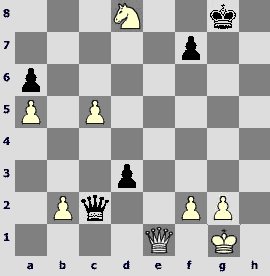
33...Јe2 34.Јf1. After 34.Јc3 d2 35.Јg3+ ўf8 36.Јd6+ ўe8 37.Јc6+! ўxd8 38.Јd6+ ўe8 39.Јb8+ ўe7 40.Јd6+ it is a draw also, but with some disturbances for White.
34...Јc2! 35.Јe1 Јe2. Black in his turn might make sure for a cost of the small jitters that in case of 35...d2 36.Јe8+ ўh7 37.Јxf7+ White cannot put his knight into operation with a tempo, and the game ends by perpetual check.
36.Јf1 Јc2. Draw.
Let us proceed to games with strongly pronounced co-authorship of one of the partners.
I.Ivanisevic – I.Miladinovic
1st Serbian league
1.d4 d5 2.c4 dxc4 3.e3 ¤f6 4.Ґxc4 e6 5.¤f3 a6 6.0–0 b5. 6...c5 leads to the one of the most worn out positions in chess history.
7.Ґb3. Surely possible is 7.Ґd3 and (for most cunning people) 7.Ґe2.
7...Ґb7 8.¤c3. The alternative is 8.a4.
8...¤bd7. Here normal 8...c5 would also return the game to a smooth theoretical rut. However, Igor Miladinovic, one of the biggest specialists on 'Trompovsky' (as was unforgettable Genrikh Chepukaitis), is not a worshipper of the notorious weak-sighted lady.
9.¦e1 c5. Deserves attention 9...b4!? trying to slow down the white e-pawn.
10.e4 cxd4 11.¤xd4 ¤e5. The move almost never occurred. Discussions were carried on around 11...¤c5:
a) 12.Ґc2 e5 13.¤f3 Јxd1 14.¦xd1 ¤cxe4 15.¤xe4 Ґxe4 16.Ґxe4 ¤xe4 17.¤xe5 Ґc5 18.¤d3 0–0–0 19.Ґf4 Ґb6 with equality, Yurtaev – Anastasian, Abu Dhabi 1999;
b) 12.f3 ¤xb3 13.¤xb3 Ґe7 14.Ґe3 0–0 15.Ґc5 Ґxc5+ 16.¤xc5 Јb6 17.Јd4 ¦fd8 18.Јf2, and Black is also close to equalization, Graf – Nguyen Anh Dung, Jakarta 1997;
c) 12.Ґd5!? (an interesting idea, which Black, however, efficiently reacted to) 12...¤xd5 13.exd5 b4! 14.dxe6 bxc3 15.Јg4 Јd5! 16.bxc3 h5 17.Јh3 ¤xe6 18.¤xe6 fxe6 19.Ґf4, and here one can probably look for something more carnivorous than 19...0–0–0?! 20.¦xe6 Јd7 21.¦b1 ¦h6 22.Ґxh6 gxh6, draw, Zvjaginsev – Yakovich, Moscow 1995;
d) 12.e5 (the most perspective line) 12...¤xb3 13.axb3 ¤d7 (13...¤d5 14.¤e4; 13...Ґc5 14.Ґe3 Ґxd4 15.Ґxd4 ¤d7 16.Јg4 0–0 Marin – V.Ivanov, Moscow 2005) 14.Јg4 b4 15.¤a4 Ґd5 Fominyh – Ganguly, Kelamabakkam 2000. Here White's position is preferable in all variations.
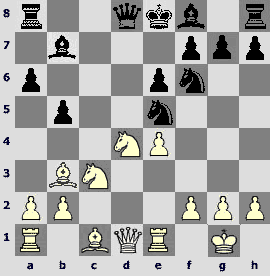
12.¤d5!? Zvjaginsev's 12.Ґd5!? seems even stronger.
12...Ґc5. 12...exd5 13.exd5 Ґd6 14.f4 is to White's benefit. Alas, Miladinovic could not stand temptation on the next move.
13.Ґf4 exd5? 13...¤fd7 led to a complicated play. Instead, after accepting the sacrifice Black immediately falls under pressure.
14.exd5 0–0 15.¦xe5 Ґd6. Black cannot capture the pawn: 15...¤xd5 16.Ґxd5 Ґxd5 17.¤f5 with a horizontal roentgen, or, more complex, 15...Ґxd5 16.Ґxd5 ¤xd5 17.¤c6 Ґxf2+ 18.ўxf2 Јb6+ (after 18...¤xf4 19.¤xd8 ¦fxd8 a funny position arises: the queen cannot retreat so that after a check from d3 the e5 rook be defended, but there is no need in it – 20.Јxd8+ ¦xd8 21.¦d1! ¦c8 22.¦c5!, and White is an exchange up and possesses both open files, winning easily) 19.Ґe3 ¤xe3 20.¤e7+ ўh8 21.¦xe3, and White has an extra piece after the fight.
16.¤f5! An excellent move clarifying the situation.
16...Ґxe5 17.Ґxe5. The d5 pawn is defended by a check from e7.
17...Ґc8. There is nothing better.
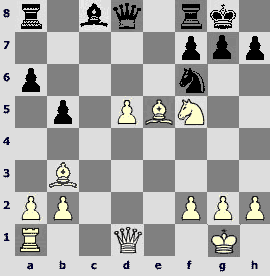
18.¤xg7! ¤e4. After 18...ўxg7 Black could not unpin. Here is an approximate variation: 19.Јd2 (threatening with Јg5+) 19...h6 (on 19...Ґf5, with the idea to put the bishop on g6, wins 20.g4!) 20.Јf4 ¦e8 21.Ґd4 (now Black must think what he could oppose to unhurried transferring the rook to g3) 21...Ґb7 22.¦d1 ¦c8 23.h4 ¦c4 24.Ґxc4 bxc4 25.g4, and White wins. Probably Black might defend more persistently here, but it does not matter as computer offers not to postpone the execution and play 19.Јh5 h6 20.g4! ¦g8 21.ўf1 with unavoidable g4-g5.
Comparatively better is 18...¤g4 and further, say 19.Ґd4 Јd6 20.g3 Јh6 21.h4 ¤f6 22.¦c1! (22.Ґxf6 Јxf6 23.¤h5 Јxb2 24.¦b1 Јe5 is not so clear) 22...Ґg4! (22...Ґd7 is refuted by 23.¦c6! Ґxc6 24.¤f5) 23.¤f5! (in case of 23.Јe1 ¦fc8 Black may have some hope for a happy outcome) 23...Ґxf5 24.¦c6 Јh5 25.¦xf6 Јxd1+ 26.Ґxd1 Ґe4 27.d6, though White has a significant advantage in the endgame all the same. Moreover, he has many worthy alternatives along the line, for example 22.¤e6!, while Black cannot boast of wide choice.
19.Ґd4. If this game was that of advanced chess it would end in a few moves: 19.Јd4!
a) 19...¤d6 20.Ґf6 Јd7 21.¤e6!;
b) 19...¤g5 20.¤h5;
c) 19...Јh4 20.d6 (preventing f7-f6 and gaining the knight comfortably, though simple 20.f3 would be enough too);
d) 19...f6
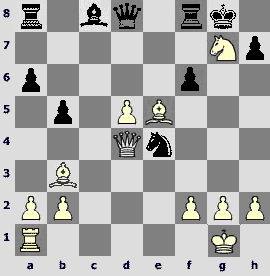
20.Ґc7! What a move! I assume, Semen Dvoirys is able, examining intently the opposite side of the board, to strike a similar treacherous side blow; maybe a few more talented chessplayers can be found, but it will never be a mass occurrence. 20...Јd7 21.¤e6, and it is time to sign scoresheets.
19.Јf3 also leads to an overwhelming advantage for White.
19...Јh4 20.h3. In order to prevent Black from replying Ґg4 on ¤h5. White's position is so good that it also admits the queens exchange after 20.Јh5! Јxh5 21.¤xh5.
20...¤f6 21.¦c1! White does not care about his knight – see the comments to the 18th move.
21...ўxg7 22.¦c3. 22.¦c6 is equally good.
22...¦e8 23.¦g3+ ўh8. In case of 23...ўf8 24.Ґc5+ ¦e7 practically any move will do, for instance 25.¦e3.
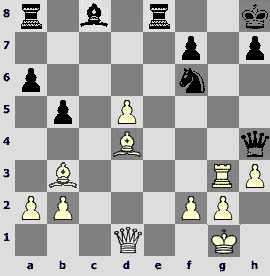
24.Ґc3! Stronger and more high-principled than 24.¦f3 ¦e1+ 25.Јxe1 Јxd4 26.Јe7.
24...b4. 24...¦g8 25.Јh5! (25.Јf3ќ) 25...Јxh5 26.Ґxf6+ ¦g7 27.¦xg7 Јf5 28.¦g6+ Јxf6 29.¦xf6 would be more pleasant to see. Though Black could resist meaninglessly for some ten moves more, decreasing the aesthetic impression. In the game the catharsis comes immediately.
25.Јd4! ¦e1+ 26.ўh2. Black resigned.
Now let me give commentator's place to grandmaster Ruslan Scherbakov, my colleague in the daily English-language internet newspaper ChessToday (Chief Editor grandmaster Alexander Baburin). It is a coincidence that in both games commented by Ruslan white kings were dragged across the board and were finished off by spectacular mates. Enjoy!
J.Werle – I.Sokolov
Staunton Memorial
1.d4 ¤f6 2.c4 c6 3.¤c3 d5 4.e3 a6. Chebanenko System is on of the basic ones employed by Ivan Sokolov.
5.Ґd3 dxc4. A good idea: Black transfers the game into a kind of QGA. Other popular possibilities 5...b5 and 5...Ґg4 are more characteristic for the Chebanenko System.
6.Ґxc4 b5 7.Ґe2. 7.Ґb3 and 7.Ґd3 are also playable.
7...e6 8.¤f3 c5. A rather intricate moves order has led to the QGA position usually arising after 1.d4 d5 2.c4 dxc4 3.¤f3 ¤f6 4.e3 e6 5.Ґxc4 a6, and if White plays here 6.¤c3 b5 7.Ґe2 c5 then the text position is reached.
9.e4. In case of 9.0–0 Ґb7 Black is all right, however, the text move does not promise an advantage too.
9...cxd4 10.Јxd4 Јxd4 11.¤xd4.
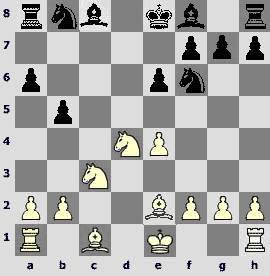
11...b4!? This interesting and ambitious move is a novelty. In Clemens – Henrichs, Hoogeveen 2005, Black played 11...¤bd7, and after 12.f3 Ґb7 13.Ґe3 Ґd6 14.0–0 ўe7 15.¤b3 b4 a draw was agreed.
12.¤a4 ¤xe4 13.¤b6. On 13.f3 ¤f6 14.¤b6 would also follow 14...Ґc5!
13...Ґc5! 14.¤xc8. 14.¤xa8 Ґxd4 15.f3 ¤c3!? Does not look attractive for White.
14...¤d7. On 14...Ґxd4! White would reply 15.Ґf3 ¤d7 16.¤d6+! ¤xd6 17.Ґxa8 ўe7 18.Ґf3 gaining an exchange. However, Black would retain acceptable compensation.
15.Ґe3 ¦xc8 16.Ґxa6 ¦b8 17.ўe2. 17.Ґd3!? ¤ef6 18.ўe2 ¤d5 19.¦hc1 with some advantage deserved considering.
17...e5.
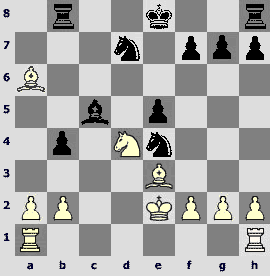
18.¤f5? It is difficult to believe that this active move is in fact a big step towards a precipice. White should continue 18.¤b3! Ґxe3 19.ўxe3 ¤ef6 20.¦ac1 with a good play.
18...g6 19.¤g3. This natural move may not be the best also. Queer 19.¤h6!? deserved serious attention: 19...f5 20.¦hd1 ўe7 21.¤f7! Ґxe3 22.ўxe3 ¦hf8 23.¦xd7+ ўxd7 24.¤xe5+ ўe6 25.f4 with good chances to save half a point.
19...Ґxe3 20.ўxe3. If White could imagine troubles waiting for him after the capture, he would consider 20.fxe3!? seriously.
20...¤ec5 21.Ґc4 f5!
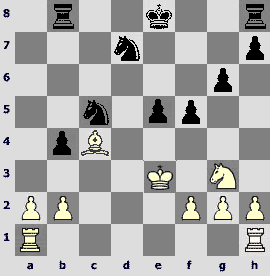
Unexpectedly, White faces concrete and very serious problems.
22.f4 ¤b6 23.¦ac1. In case of 23.Ґb5+ Black obtains big advantage by 23...ўe7 24.¦hd1 ¤ba4 25.Ґxa4 ¤xa4.
23...exf4+ 24.ўxf4 ¤xc4 25.¦xc4 ¤d3+ 26.ўg5?! After 26.ўe3 ¤xb2 27.¦c2 ¤a4 Black has a sound extra pawn, but it is not improbable that White could resist more persistently in this case.
26...h6+! A very strong and well-calculated move!
27.ўxg6. White believes in various tactical tricks, but it fails. There is little joy in the position after 27.ўh4 0–0 but it was the only way to continue struggling.
27...¤e5+ 28.ўg7.
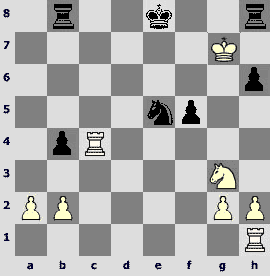
28...ўe7! Suddenly the white king begins to feel uneasy! 28...ўd7? was obviously less accurate in view of 29.¦xb4!! (29.¦d1+?? ўe6°) 29...¦bg8+ (29...¦hg8+ 30.ўh7) 30.ўf6 ¤g4+ 31.ўf7! ¤e5+ 32.ўf6, and White escapes.
29.¤xf5+ ўe6 30.¤d4+ ўd5!

Both kings are working hard but their destinies differ...
31.¦xb4. White keeps material balance resourcefully, but...
31...¦bg8+ 32.ўf6 ¦g6+ 33.ўe7 ¦h7+ 34.ўf8 ¦f7+ 35.ўe8 ¦g8#

Mate!
M.N.: While Ruslan is putting pieces into place to show the next game where the Dutch defence was played, I will tighter bind the two duels with the help of a reading-book example from the chess treasury.
Ed.Lasker – G.Thomas
London 1912
1.d4 f5 2.e4 fxe4 3.¤c3 ¤f6 4.Ґg5 e6 5.¤xe4 Ґe7 6.Ґxf6 Ґxf6 7.¤f3 0–0 8.Ґd3 b6 9.¤e5 Ґb7 10.Јh5 Јe7.
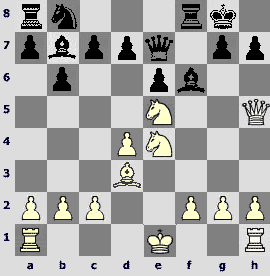
11.Јxh7+ ўxh7 12.¤xf6+ ўh6 13.¤eg4+ ўg5 14.h4+ ўf4 15.g3+ ўf3 16.Ґe2+ ўg2 17.¦h2+ ўg1 18.ўd2#.
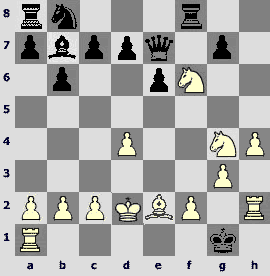
And now, almost a hundred years later, on the other side of the Channel...
R.Fontaine – M.Vachier-Lagrave
French Championship
1.¤f3 f5 2.d4 ¤f6 3.g3 g6 4.Ґg2 Ґg7 5.0–0 0–0 6.c4 d6 7.¤c3. The Leningrad variation of the Dutch defence leads to positions with upset strategic balance and somewhat better chances for White. Nevertheless, Black also gets opportunities to outplay his opponent.
7...¤c6. Both 7...Јe8 and 7...c6 are known as more reliable continuations.
8.b3. Usually they play 8.d5 promising slightly better chances for White according to the tournament practice.
8...e5. Black tried many other moves, but this one is the most logical.
9.dxe5 dxe5 10.Ґa3.
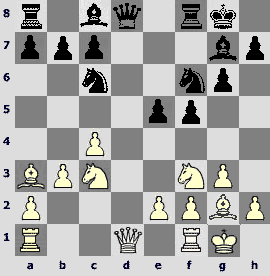
10...e4!? The decision quite resembles a typical exchange sacrifice in the King's Indian but leads to a better position for White objectively. Nonetheless, Black's bold treatment deserves the exclamatory sign. And it brought a success in the end! 10...¦e8 was fully acceptable.
11.Ґxf8 Јxf8 12.¤d4 ¤xd4 13.Јxd4 Ґe6 14.Јd2!? A helpful move: White withdraws his queen from the dangerous diagonal.
14...h5!? Only this advancing the pawn is a novelty. Black looks for chances on the kingside, so he does not put his only rook on the open file where it could be exchanged. Earlier, Black used to play 14...¦d8
a) 15.Јc2 e3! 16.¦ad1 (16.fxe3 ¤g4 17.¦f3 Ґh6 with a compensation) 16...exf2+ 17.ўh1 ¤g4 18.¦xd8 Јxd8 19.¤d1 c6 with a good compensation for the exchange, though White's chances are preferable all the same, Lesiege – Zugic, Montreal 1999;
b) 15.Јc1 c6 16.¦b1 h5 17.¦d1 ¦e8 18.e3 (after 18.Јd2 h4 19.gxh4 ¤h5 Black obtained a very active play against the opponent's vulnerable kingside, Spacek – Motwani, Luxembourg 1990) 18...h4 19.¤e2 hxg3 20.hxg3 ¤g4 21.¤f4 Ґf7 22.¦d7 ¦b8 23.Јd2, and White proved his advantage in Bormida – M.Frank 1998.
15.¦ad1 h4.
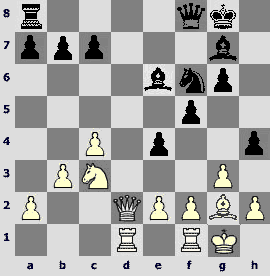
16.Јg5. The move is not bad at all but it assists Black's play on the kingside.
16...ўf7 17.Јf4 Јc5 18.¤b5. 18.g4!? deserved serious attention. Black may think of the counterblow 18...h3!? but after 21.¤a4!? Јa5 22.Јe3 Ґf8 23.ўh1 White retains better chances.
18...hxg3 19.hxg3 ¦c8 20.¤d4 Ґd7.

21.g4? Here this enticing stroke helps Black to develop his initiative. Deterring 21.¤c2!? would be more appropriate.
21...¤xg4 22.¤xf5. This interesting blow does not trouble Black too much: his resources are more than sufficient. But in any case he is good already, for example 22.Ґxe4 Ґe5 23.Јf3 Ґxd4 24.Ґxb7 ¦b8 25.Јd5+ Ґe6 или 22.¤f3 Јe7 23.¤g5+ ўe8 and so on.
22...Ґxf5 23.¦d5.

23...Јxd5!? Maybe 23...Јf8!? is stronger objectively, but it was so difficult to resist temptation to sacrifice the queen.
24.cxd5 Ґe5 25.Јc1 Ґh2+ 26.ўh1 ¦h8. Black has only two minor pieces for the queen but he plays with a guaranteed draw – it is White who must be careful.
27.Јc4. If White knew what was awaiting for him, he would think of 27.e3!?
27...Ґd6+ 28.ўg1 Ґh2+ 29.ўh1 b5!?
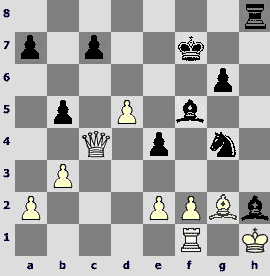
30.Јxb5? White should forbear from this impulsive capture, which resulted in the queen's losing all its strength. After correct 30.Јc6! White holds his position, for instance 30...e3 31.Ґf3 ¤xf2+ 32.¦xf2 exf2 33.ўg2 Ґg3 34.ўxg3 f1Ј 35.Јxc7+ with perpetual check.
30...e3! 31.Ґf3 ¤xf2+ 32.¦xf2. 32.ўg2 will not do in view of 32...Ґh3+! 33.ўxh2 Ґd7+.
32...exf2 33.ўg2 Ґg1 34.Јc6? The only possibility to continue struggling was 34.ўf1! Black would then play 34...¦h2 35.Ґg2 ¦xg2! 36.Јc4! (36.ўxg2? Ґh3+!°) 36...¦h2 37.Јxc7+ (37.d6+ ўf8 38.Јf4 ўe8! 39.Јa4+ ўd8 40.dxc7+ ўxc7 41.Јxa7+ ўd6, and the king runs away to the kingside) 37...ўg8 38.Јb8+ ўh7 39.Јc7+ ўh6 40.Јf4+ ўh5 41.Јe5 ¦h4 42.Јh8+ ўg4, and he must win gradually, though the white queen is still very importunate.
34...¦h2+ 35.ўg3.
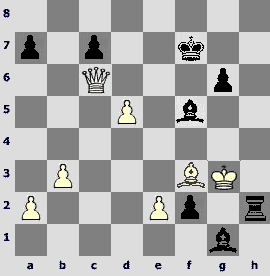
35...f1¤+!!An astounding resource! 35...f1Ј?? led only to perpetual check after 36.Јxc7+ ўe8 (or 36...ўg8 37.Јd8+ ўh7 38.Јe7+ ўh6 39.Јf8+) 37.Јe5+ ўd7 38.Јg7+ ўc8 39.Јc3+ and so on.
36.ўf4 ¦h4+ 37.ўg5.
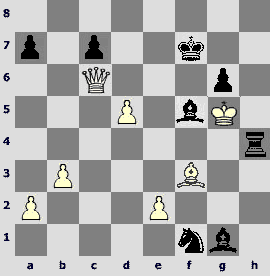
37...Ґe3+!! Wonderful! Similar combinations are extremely rare in the tournament practice.
38.ўxh4 g5+ 39.ўh5 ¤g3+. The newborn knight makes his first move with the decisive effect. White resigned, not waiting for being checkmated after g5-g4 on the next move.
* * *
Here I will finish my review. I hope you always to keep your head cold and your king warm!

Discuss in forum